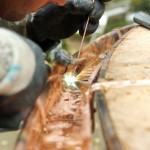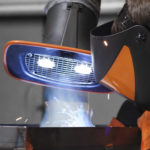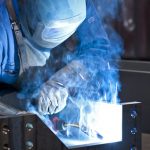Welding in confined spaces: How welders protect themselves effectively
Welding positions while processing workpieces is not always ideal for welders. Especially when welding in confined spaces, they reach the limits in reliability of their own safety equipment. When it comes the extraction of welding fumes, the welder himself is particularly important.
Lying under piping crawling into narrow conduits, kneeling in tight containers: Welding is often uncomfortable. Welding in confined spaces, poses a major risk factor in today’s working environment. The forced posture, to put it mildly, is thereby the lesser evil: Burns, welding fumes and electricity among other things, play a role. Dangers arise especially incontainers, apparatuses, boilers, tanks, hollow spaces in structures and machines, windowless structures such as basements, duct systems or tunnels.
Confined spaces are clearly defined. They are spaces, which are normally enclosed by solid walls, have no natural air vent, a volume of less than 100 cubic meters of air and at least one dimension less than 2 meters in length, width or height.
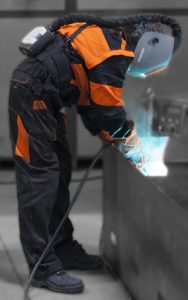 Welding fumes, Electricity, Forced Posture: The hazards of welding in confined spaces
Welding fumes, Electricity, Forced Posture: The hazards of welding in confined spaces
The hazards that lurk in confined-space welding are as varied as welding itself. The following risks are the most common sources of danger:
- Gas, steam or dust, which can cause fires, deflagrations or explosions
- Gas, steam or dust that reach harmful concentrations. This includes above all, is nitrous gasses
- Excess oxygen that can cause fires and burns
- Oxygen shortages that can lead to suffocation. For example, when using inert gas to protect the material from the effects of oxygen, through chemical reactions or unsuitable and inaccessible ventilation.
- Hot materials, which can generate additional heat in the space
- Excessive contact voltage when using electric hand lamps, tools, welding devices or other electrical equipment.
- Limited freedom of movement as well as forced postures
How welders avoid danger when welding in confined spaces
The sources of danger when welding in confined spaces can hardly be more varied. For this reason, it is essential to minimize them before beginning the welding process. Before starting work, welders should therefore…
- Remove dangerous working materials and gasses
- Check whether electrical current sources could pose a danger. The appropriate and especially well identified welding power sources should be used (labelling ), as well as insulating layers such as rubber matting or wooden grating.
- Always stay aware of gas emissions. During longer breaks for example, oxy-acetylene cutters and hoses must be removed or at least separated from the gas feed.
- Obtain the written approval for welding from the operating company and specify the safety measures therein.
- Specify a dedicated supervisor, who ensures that the defined safety measures are taken during the work.
- Designate a reliable safety post, which maintains contact with the welder in the form of visual or voice contact, or signal lines. When in doubt, this person must seek help. They must be trained in safety and rescue operations
- Take precautions for quickly exiting the danger zone, via sufficiently large exit ways, in the event of an emergency.
- Keep escape routes clear
- Ensure that the appropriate personal protective equipment is used, which depending on the welding application, ranges from dry flame-retardant clothing to respiratory protective equipment.
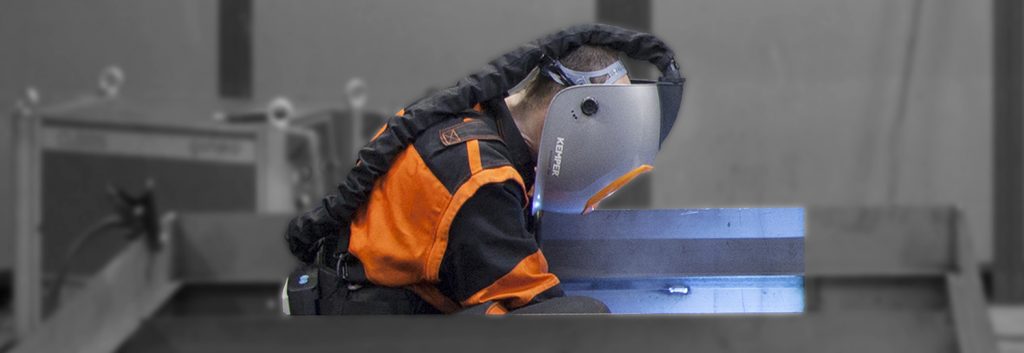 The special importance of air quality management when welding in confined spaces
The special importance of air quality management when welding in confined spaces
When welding in confined spaces, the ambient air quality is of particular importance. Welders must ensure that the entire space contains healthy, breathable air at all times. Through the confinement and spatial enclosure of the environment, natural ventilation in most cases is insufficient. Most of all, an oxygen content of 17% must be ensured through the appropriate ventilation.
If welding fumes are generated, companies must also comply with the statutory workstation limits when welding in confined spaces. The difficulty thereby, is ensuring effective welding fume extraction in the workplace. This is also and above all, when welding in confined spaces, achieved through spot extraction. For example, through efficient extraction burners or hoods near the welding site.
It’s up to the welders themselves to implement fume extraction technology properly. Mobile extraction units however, cannot be taken into electrically confined spaces. With damaged connecting cables for example, the pose a particular electrical hazard. Even welding devices used in such applications can only operate with a limited voltage.
If spot extraction is not possible at all, ventilating the entire space is an option. Companies should thereby select an air supply and exhaust solution. To ensure a continuous flow of air, the supply and exhaust must be at different locations.
Further ventilation tips beyond welding fume extraction
If ventilation is not possible, the welder must use the appropriate breathing apparatus. The respiratory device however, must be independent of the ambient air. Suitable breathing protection is therefore not a filtered breathing device, rather exclusively self-contained respirator devices with a hose connected externally.
To generate a higher oxygen content, the confined space cannot be ventilated with oxygen. A danger of explosion is thereby created.



